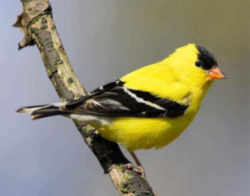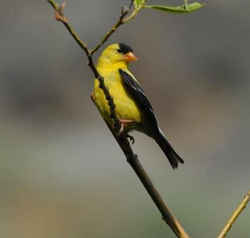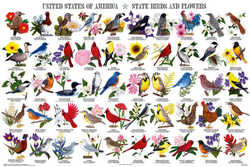Iowa State Bird
Eastern Goldfinch now American Goldfinch aka Wild Canary

(Carduelis tristis)
Adopted on March 22, 1933.
The Iowa State Legislature designated the Eastern Goldfinch, (Carduelis tristis,) also known as the Wild Canary, as the official
state bird of Iowa which was approved by the Iowa House of Representatives on Mary 21 and the Iowa Senate on March 22, 1933. It was chosen as the state
bird because it is commonly found in Iowa and often stays through the winter. The eastern goldfinch, adopted by the 1933 Iowa Legislature and recorded
as Spinus tristis tristia, is now referred to as the American goldfinch and has been classified as Carduelis tristis.
Seeds from dandelions, sunflowers, ragweed, and evening primrose are the main source of food for the Eastern Goldfinch (Carduelis tristis). In late July or early August they build their nests from plant materials and line them with thistledown. The pale blue-white eggs of the Eastern Goldfinch incubate for two weeks and the young birds leave the nest when they are two to three weeks old.
The American Goldfinch is the state bird of Iowa, New Jersey, and Washington
Iowa State Bird: Eastern Goldfinch

The brightly colored male American goldfinch is especially recognizable. The American regularly visits seed feeders, particularly in the east. It is often very gregarious, especially during the nonbreeding season, when it flocks to roadsides and brushy fields to feed on thistle and sunflowers. It is often heard in flight, giving distinct flight calls.
Characteristics of the Eastern Goldfinch
A small finch, 13 cm (5 in) from tip of bill to tip of tail. The top of the male's head is topped with black. The bright yellow body has black wings and tail. The base of the tail is white above and below. The female has a dull olive-yellow body with a brown tail and wings. The male goldfinch acquires the same dull plumage in the winter months. Females in both seasons are duller than males.
The short breeding season begins in July and lasts until mid-September. Breeding habitat is typically weedy fields with shrubs, but the Goldfinch will sometimes nest in open woodlands. The female builds a cup-shaped nest less than 1-10 m (1-30 ft) above ground in a shrubby plant or coniferous tree. The female lays 4 - 6 pale blue eggs, which she incubates for 12-14 days. The male feeds the female on the nest. When the eggs hatch, the female feeds the young regurgitated seeds. Nestlings are altricial and fledge after about 15 days. The parents continue to feed the begging fledglings for up to 3 more weeks. Some females are sequentially polyandrous. After the first brood hatches, the female leaves the brood in care of their father and finds another male for a second nesting attempt.
During the winter, the American Goldfinch migrates. This species often forms large foraging flocks, sometimes with other species, including Chickadees, siskins, and other finches. Preferred foraging areas include weedy and cultivated fields, orchards, and flood plains. The Goldfinch forages mainly on seeds of thistle and other many-seeded flowers, grasses, and deciduous trees. Predators include snakes, birds, cats, and squirrels. The Brown-headed Cowbird sometimes lays one egg in the Goldfinch nest, which reduces Goldfinch clutch size. Although the Cowbird egg usually hatches, the Cowbird nestling usually does not survive, probably because it is not well suited for the diet of seeds.
In winter, the American Goldfinch occurs throughout Georgia where suitable habitat is present. It may be found year-round in the northern parts of the state. The species' range extends throughout the United States
Iowa Concurrent Resolution No. 22
Concurrent Resolution No. 22, designating the eastern goldfinch (Spinus tristis tristia) the official state bird of Iowa, was approved by the Iowa House of Representatives on May 21 and the Iowa Senate on March 22, 1933. Concurrent Resolution No. 22 read, in part:
"Whereas, many states have not only adopted certain named flowers as their state flowers, but have also adopted certain named
birds as their state birds, and
Whereas, the Iowa Ornithological Union, an association comprising students and lovers of birds, residing in our state at their annual meeting held
in Des Moines, Iowa, in May, 1922, by resolution and vote designated the Eastern Goldfinch as their choice for a state bird, and recommended that the
Eastern Goldfinch be adopted as the official state bird of Iowa, therefore
Be it Resolved by the House of Representatives, the Senate concurring, that the Eastern Goldfinch, Spinus tristis tristia, is hereby designated and
shall hereafter be officially known as the state bird of Iowa."
Iowa Statute
The state bird was approved by Concurrent Resolution and is not part of the Iowa Code.
Taxonomic Hierarchy: American Goldfinch (Wild Canary)
Kingdom: Animalia - animals
Phylum: Chordata - chordates
Subphylum: Vertebrata - vertebrates
Class: Aves - birds
Order: Passeriformes - perching birds
Family: Fringillidae - buntings, finches, grosbeaks, old world finches, sparrows
Genus: Carduelis Brisson, 1760 - goldfinches
Species: Carduelis tristis (Linnaeus, 1758) - american goldfinch, Jilguero canario








